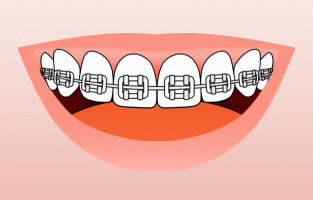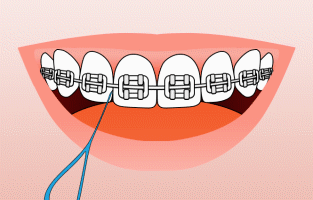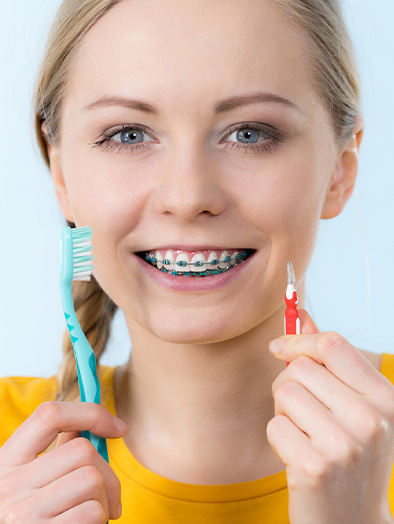Brushing and Flossing
When you have braces, it's very important to brush and floss after every meal in order to keep your teeth and gums healthy throughout your orthodontic treatment. If you need help choosing the right toothbrush, toothpaste, and dental floss, please ask us and we can help you choose the right products for your teeth and your appliance.
Brushing with Braces
Brush your teeth for two minutes after every meal with a soft-bristled, small-headed toothbrush and fluoride toothpaste. As an alternative, you can use a powered toothbrush to increase your brushing effectiveness. Brush the outside and inside surfaces of your teeth using small, gentle, circular motions while positioning the head of the toothbrush at a 45-degree angle to the gum line. Brush your teeth’s chewing surfaces and the inside surface of your front teeth using short, gentle, back-and-forth motions. Pay close attention to the areas around your brackets or other appliances.

Flossing with Braces
Flossing after every meal will help keep your teeth and braces clean, which will also help keep your treatment time on track. To floss with braces, use a floss threader or special orthodontic floss to thread the floss behind each wire. Wrap the ends of the floss around your pointer fingers of both hands, leaving a few inches of taut floss between them. Gently slide the floss between each set of teeth using a back and forth motion. Floss the sides of each tooth beneath the gum line to remove plaque and food particles. Repeat this process until you’ve flossed all of your teeth. If you find that your floss is not removing all of the food particles between your teeth and around your braces, ask us about a water flosser!

Extra Tips for a Healthy Smile with Braces
- Use fluoride toothpaste: This helps strengthen enamel and prevent cavities.
- Avoid sticky and sugary foods: These can increase plaque buildup and make cleaning harder.
- Rinse with mouthwash: An alcohol-free fluoride rinse can help wash away bacteria and strengthen enamel.
- Keep up with regular dental cleanings: In addition to your orthodontic visits, continue seeing your dentist for professional cleanings.







